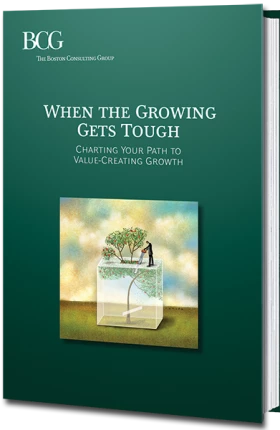A Growth Zealot’s Guide to Commercial Transformation sets the stage for companies to trigger new and untapped growth by exploiting the “Go-to-Market Revolution” hidden in their existing marketing, sales, pricing, and other commercial functions. At little cost or risk, companies can create short-term revenue growth that simultaneously funds long-term profit as well as the development of new strategic capabilities.
BCG’s new e-book outlines steps executives can take to rethink and retool their go-to-market commercial capabilities to build revenue quickly now while supporting strategic success in the future.
Six chapters organized by commercial function discuss how companies can define their own customized approach to winning with growth.
Chapter 1: Marketing
Choosing More Rigor or Rigor Mortis
- More than $1 trillion is spent globally each year on marketing, often with less-than-optimal analysis of the return on that investment. There is an alternative. Companies can maximize long-term impact by using an approach that manages all commercial investments, integrating a top-down strategic perspective with rigorous bottom-up analysis.
- The Millennial generation is changing the nature and practice of consumer marketing—through peer reviews, blogs, social media postings, and other online and offline advocacy. Millennials expect a two-way, mutual relationship with companies and brands: BCG calls this the reciprocity principle.
- The largest global marketers are ramping up spending in rapidly developing economies (RDEs). But many companies have limited ability to assess results or optimize returns. We identify five practical steps marketers can take to jump-start their marketing effectiveness in RDEs.
Chapter 2: Branding
The Death of Linear Logic
- Delivering a compelling brand experience isn’t just an art. It’s also a science, rooted in data-driven insight and discipline. The company-driven linear model of traditional brand engagement is dead. Learn to retool your marketing and branding for today’s ecosystem of multidirectional engagement.
- Brand advocacy —word-of-mouth recommendations, “likes,” and critiques by consumers—have unparalleled impact. But companies struggle to measure advocacy or exploit it in the marketplace. BCG’s Brand Advocacy Index offers a precise metric for measuring advocacy and its outcome.
Chapter 3: Sales
A Darwinian Moment in Sales Force Evolution
- The sales force of the twenty-first century is evolving in profound ways—not by choice but for survival. Some companies are adapting their models, enhancing their data and analytics, and increasing revenues incrementally by 10 percent or more.
- Adept companies are dissolving the boundaries between marketing and sales—and sharpening sales force effectiveness to jump-start growth. The authors outline a process for rethinking and honing sales capabilities to make even top-performing teams more productive.
Chapter 4: Pricing
The Language of Growth Zealots
- Billions of dollars can be made by accurately anticipating how to target the right customers with the right offer at the right time and motivate them to respond. That requires a data-driven approach to map and master what BCG calls the customer pathway.
Chapter 5: Consumer and Customer Insight
Hearing the Call to Action
- Even the most sophisticated companies face crucial gaps in customer insight. The authors discuss how all companies can acquire the data and capabilities needed to build truly deep and actionable consumer intelligence and distribute it throughout the enterprise.
- Big data and advanced research capabilities could be called the go-to-market arsenal of customer insight. They bolster the science that enables companies to merge data sets from multiple sources and extended time periods. Learn to master the tools that allow you to understand purchase drivers, recognize patterns, and predict behaviors.
Chapter 6: Globalization
Tapping the Emerging-Market Engines of Growth
- Competition is intensifying in rapidly developing economies, the no-longer-new sources of global growth. Astute companies are already transforming their RDE commercial capabilities to create fresh opportunities. Some are using digital and mobile technologies to segment national markets into thousands of previously hidden pools of customers.





